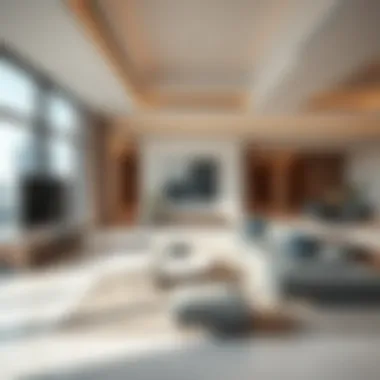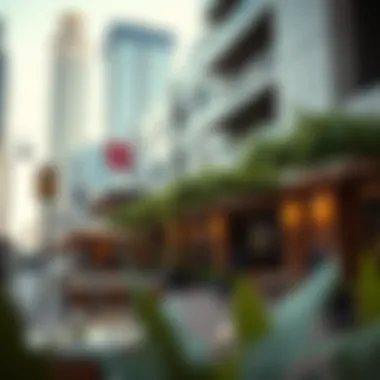Exploring Downtown Residences in Dubai


Intro
As Dubai continues to blossom as a global hub of commerce and culture, the allure of downtown residences becomes increasingly evident. These spaces, characterized by a blend of modern architecture and vibrant urban life, cater to a diverse array of residents—from international investors to young professionals seeking a dynamic lifestyle. The appeal goes beyond mere aesthetics; it encompasses convenience, cultural richness, and potential financial yield.
Exploring the intricate layers that define downtown living in Dubai opens a dialogue about the socio-economic shifts, real estate movements, and emerging trends that shape the market today. This guide aims to provide a comprehensive overview that not only highlights the architectural and design features unique to these spaces but also delves into the underlying market dynamics and investment strategies relevant to both newcomers and seasoned players in the real estate landscape.
Market Trends
Current Market Analysis
The real estate market in downtown Dubai is a reflection of broader economic patterns, influenced by various factors such as tourism, expatriate demographics, and the burgeoning tech scene. As of late 2023, analysts note an uptick in property values across various neighborhoods, driven primarily by high demand and limited supply.
Some key observations include:
- Strong Rental Yields: Downtown areas are showing rental yields of approximately 6-8%, making them attractive for investors focusing on cash flow.
- Sustainability Moves: New developments emphasize eco-friendly designs, attracting buyers with an eye on sustainable living.
- Cultural Investment: Initiatives like the Dubai Opera and various art galleries enhance the cultural fabric of the community, drawing in those seeking a rich lifestyle experience.
Future Projections
Looking ahead, several projections can be made about the downtown real estate market. Analysts expect a continued rise in property values, fueled by the anticipated influx of expatriates and high-net-worth individuals.
"The combination of lifestyle amenities and a robust business environment is likely to draw more families and young professionals to downtown projects, keeping the demand strong," shares Ali Al-Mansoori, a local real estate analyst.
Potential factors to keep an eye on include:
- Strategic Developments: Infrastructure projects such as the metro expansion and new recreational hubs may further enhance accessibility and attractiveness.
- Evolving Buyer Demographics: Millennials and Gen Z are increasingly becoming key players in the residential market, desiring modern amenities and community-oriented living.
- Tech Influence: An uptick in tech companies creating bases in the heart of the city could also augur well for residential demand, as young professionals flock to urban centers pursuing both work and lifestyle flexibility.
Investment Strategies
Best Neighborhoods to Invest In
When it comes to smart investments, choosing the right neighborhood can make all the difference. Areas like Downtown Dubai, Business Bay, and Dubai Marina consistently resonate with both investors and tenants.
Downtown Dubai stands out for its iconic skyscrapers and proximity to major attractions like the Burj Khalifa and The Dubai Mall. Business Bay offers a thriving business environment coupled with upscale living options, making it appealing for professionals. Meanwhile, Dubai Marina is known for its waterfront properties and vibrant nightlife, attracting a younger demographic.
Tips for First-Time Investors
For those diving into the downtown property market for the first time, there are strategies that can help you navigate the waters:
- Do Your Homework: Research market trends, property history, and future developments. Knowledge is your best ally.
- Work with Local Experts: Connect with real estate agents specializing in downtown properties. Having someone who understands the nuances can save you time and money.
- Consider Long-Term Potential: While immediate returns are enticing, look for properties that promise long-term value growth.
- Visit Properties in Person: Pictures can be misleading. Visiting potential investments allows you to gauge location, amenities, and overall vibe directly.
Understanding the market and implementing strategic investment practices can help set the foundation for successful ventures in downtown Dubai’s real estate arena. It's a world where the right choices could lead not just to significant returns, but also to a fulfilling lifestyle in one of the most dynamic cities on the globe.
Understanding Downtown Residences
Understanding downtown residences is crucial for anyone looking to delve into the dynamic real estate market of Dubai. The city itself, vibrant and constantly evolving, is a melting pot of cultures, lifestyles, and opportunities. Recognizing the nuances of downtown living can offer invaluable insights into not just buying or renting a property, but also appreciating the broader implications on lifestyle, investment, and urban development.
Defining Downtown Living
Downtown living generally refers to residing in the heart of urban centers where activity never sleeps. In Dubai, this means being near cultural landmarks, innovative architecture, and bustling commercial spaces. The allure of these residences lies in their accessibility. Imagine having the Burj Khalifa and the Dubai Mall a short stroll away. This immediacy translates into convenience, offering residents the ability to engage with vibrant dining scenes, entertainment options, and shopping hubs right at their doorstep.
Another defining factor is the distinct lifestyle that comes with it. Residents often experience a blend of urban sophistication and community engagement. Local markets, art galleries, and events create an atmosphere that fosters interactions among diverse groups of people. Beyond mere housing, it’s about residing in a lively ecosystem that promotes convenience and social connectivity.
Historical Context of Urban Development
The evolution of downtown residences in Dubai hasn’t been a mere coincidence, but a well-thought-out journey shaped by historical milestones. The late 20th century was pivotal for Dubai as it transitioned from a modest fishing village to a global city, firmly positioning itself on the world map. The rapid urbanization in the early 2000s fueled extensive development in the downtown area, leading to iconic structures and luxurious living spaces.
It’s also essential to recognize that urban development in Dubai is influenced by factors like economic diversification. The city was determined to move away from oil dependency, prompting investments in tourism and infrastructure. As a result, projects such as the Dubai Marina, and the rejuvenation of Deira brought to light a unique blend of traditional and contemporary styles. Thus, understanding this context helps in grasping the current trends seen in downtown residences.
Geographic Significance in Dubai
The geographic positioning of downtown Dubai plays a vital role in its desirability. Nestled strategically at the intersection of various metropolitan hubs, the area connects key districts while being accessible via major highways. This makes commuting effortless, whether you are heading to the airport or to the various free economic zones across the city.
Moreover, the proximity to major landmarks enhances the significance of this area. The lush Dubai Creek, coupled with breathtaking views of the skyline, creates an exceptional living environment.
"Location is everything. In Dubai's downtown, every corner offers a fresh perspective, blending city lights with cultural richness."
This location not only appeals to foreign investors and expatriates but also locals who seek a cosmopolitan lifestyle. In summary, the downtown area stands as a testament to Dubai's ambition, innovation, and growth, permanently shaping the fabric of urban living.
Investors and real estate professionals should deeply consider these facets when evaluating properties in downtown Dubai. The blend of convenience, history, and the geographic significance outlines the core of what makes living in downtown extraordinary.
Market Trends in Downtown Properties


The dynamics of the real estate market, particularly in bustling urban centers like Dubai, cannot be ignored. As the saying goes, "knowledge is power," and in the fast-paced world of downtown residences, understanding market trends is crucial. Analyzing current conditions, price movements, and local competition helps investors, real estate agents, and potential homeowners make informed decisions. A keen awareness of these trends not only informs strategy but also helps to anticipate shifts that could drastically impact property value.
Current Real Estate Landscape
To grasp the present state of the real estate market in downtown Dubai, we must look at various factors that influence demand and supply. Over the past few years, downtown properties have evolved into highly coveted spaces, reflecting both luxury and accessibility. With a heightened focus on urban living, developments have surged, featuring innovative designs that appeal to a broader demographic.
With the steady influx of expatriates and tourists, it remains clear that the allure of downtown living persists. In recent months, there has been a noticeable uptick in property transactions. Builders are keen to capitalize on this demand by enhancing their offerings with features that prioritize sustainable living and advanced technology.
Moreover, infrastructure improvements have been moving in tandem with real estate growth, making it easier for residents to navigate the city. The future shines bright, but stakeholders must stay alert to shifting patterns in buyer interest as preferences continue to evolve.
Price Fluctuations and Predictions
Property prices in downtown Dubai demonstrate a unique rhythm, influenced by a blend of local and global economic conditions. Although there was a dip during the pandemic, the current trend is leaning towards recovery. Prices appear to be stabilizing, a sign indicating that the market is finding its footing again. Some analysts project an incremental rise as new developments materialize and the demand increases.
On a broader scale, socioeconomic factors contribute to these fluctuations. Factors such as interest rates, governmental policies, and even currency exchange rates impact investors' behavior and the affordability of real estate.
"Investors should remain cautious but optimistic, monitoring shifts closely to seize the right opportunities at the right time.”
The temptation to jump at the first sight of a price rise can be enticing, though diligent research on neighborhood dynamics can mean the difference between a sound investment and a costly mistake.
Competitive Comparisons with Other Areas
In the competitive arena of real estate, downtown Dubai holds its own against various other regions. Notably, contrasts and comparisons with areas like Dubai Marina, Jumeirah, or Business Bay can reveal valuable insights. Downtown homes, for instance, offer proximity to significant landmarks like the Burj Khalifa and Dubai Mall, which may not be available elsewhere. This proximity often justifies the pricing, even if other districts offer larger living spaces.
When assessing overall appeal, potential buyers and investors look to factors such as lifestyle, accessibility, and community. The vibrancy of downtown living, accompanied by its rich array of cultural events and social venues, consistently gives it a competitive edge. While other neighborhoods might cater to particular niches, downtown properties generally attract a diverse market, making them a popular choice.
In summary, understanding market trends in downtown Dubai is integral for navigating this intricate landscape. By staying informed on current conditions, price variations, and competitive analyses, stakeholders can paint a clearer picture of their potential success in this dynamic sector.
Architectural Styles and Design Features
The architectural styles and design features of downtown residences significantly shape the identity and character of urban living spaces. In a diverse city like Dubai, these facets not only reflect aesthetic choices but also embody the historical and cultural narratives unique to the region. Understanding these elements helps potential investors, homebuyers, and real estate agents grasp the allure and intrinsic value of properties within the downtown area.
Iconic Structures in Downtown Dubai
In downtown Dubai, the skyline is punctuated by remarkable structures that are as much about symbolism as they are about function. The Burj Khalifa, towering at 828 meters, is not merely a residential marvel but an iconic representation of human ambition. Designed with a sleek, spiraling silhouette, its design draws from traditional Islamic architecture while embracing modernity.
Another noteworthy structure is the Dubai Mall, which integrates retail and leisure in a way that has redefined shopping experiences.
"Downtown Dubai is a testament to architectural innovation, where every building tells a story of its time."
While these structures are certainly eye-catching, they also influence the surrounding areas. Properties that showcase views of these landmarks tend to have higher market attractiveness and, consequently, better investment potential.
Modern Design Trends and Materials
Design trends in downtown residences are increasingly leaning towards functionality combined with innovative aesthetics. Open floor plans are gaining traction as they create a sense of spaciousness and cater to contemporary lifestyles, where the living, dining, and kitchen areas seamlessly merge. Large windows contribute to this trend not just for light but for views that connect residents to the vibrant urban environment.
Utilizing modern materials such as glass, steel, and sustainable composites is becoming standard in today’s architecture. Not only do these materials provide durability, but they also contribute to the energy efficiency of buildings. The use of reflective glass, for instance, not only is visually appealing but also minimizes heat gain, making living spaces more comfortable.
Furthermore, the integration of smart home technologies is reshaping how architectural designs are conceived. From automated lighting systems to state-of-the-art security features, modern residences are equipped to meet the demands of tech-savvy residents, enhancing both convenience and security.
Sustainable Building Practices
With growing awareness of environmental issues, sustainable building practices are becoming paramount in the construction of downtown residences. Developers are increasingly adopting strategies that lessen the environmental footprint of their projects. This includes using recycled materials, energy-efficient systems, and designs that maximize natural light and ventilation.
Green roofs and vertical gardens are popular, providing not just aesthetic benefits but also improving air quality and insulation. Additionally, developments like The Sustainable City leverage renewable energy sources such as solar panels, encouraging a greener lifestyle.
Investors should note that properties boasting sustainable building practices often not only appeal to eco-conscious buyers but also tend to have lower operational costs associated with utilities. Thus, investing in such properties aligns with both ethical responsibility and economic sensibility.
Investment Opportunities in Downtown Residences
Investing in downtown property is not just about having a front-row seat to the bustling city life; it’s fundamentally a strategic move that can yield tangible benefits. This section explores the myriad of investment opportunities that downtown residences present, adding depth to the understanding of this vibrant market. With the backdrop of Dubai's rapid growth and exceptional global appeal, savvy investors can find fruitful avenues for diversification and long-term financial gain.
Reasons to Invest in Downtown Property
Location, Location, Location! It’s a mantra every real estate investor knows, and for good reason. Downtown Dubai is a hub rich in culture and commerce. The proximity to prime business districts, major tourist attractions like the Burj Khalifa, and world-class dining options can't be overstated. Here are some critical reasons why investing in downtown properties is often seen as a golden opportunity:
- High Demand: Due to its status as a central business and lifestyle area, properties here remain highly sought after, which can lead to increased property values.
- Capital Growth Potential: The continuous development of infrastructure and facilities supports the potential for capital appreciation, making it an enticing proposition for investors.
- Luxury Appeal: Properties in downtown are synonymous with luxury and exclusivity. This not only attracts affluent buyers but also renters willing to pay a premium for quality living.
Such factors can result in a stable and lucrative return on investment, making downtown a front-runner in the property race.
Understanding Rental Yields
When considering property investments, understanding rental yields becomes imperative. This metric allows investors to gauge the profitability of their investment. In downtown Dubai, where short-term and long-term rentals are prevalent, the potential for yields can be substantial. Here’s what to consider:
- High Occupancy Rates: With its central location, properties tend to have high occupancy rates, ensuring that rental income remains consistent.
- Average Rental Yields: Different studies highlight that downtown residences can yield rental returns upwards of 6-8%, a figure which is often higher compared to other less prime areas in Dubai.
- Short-term Rental Opportunities: With many tourists flocking to the area, properties suitable for short-term rentals (like Airbnb) often fetch higher nightly rates, enhancing overall rental income.


Understanding these nuances can empower investors to make well-informed decisions that align with their financial objectives.
Financing Options for Buyers
Financing is a significant element when it comes to real estate investment. Various options are available to prospective buyers looking to secure a piece of downtown real estate. Potential buyers can explore the following avenues:
- Mortgages from Local Banks: Many banks in the UAE offer competitive mortgage rates, especially for expatriates. Understanding eligibility criteria can streamline the process.
- Developer Financing Plans: Some property developers offer direct financing options that may have attractive terms. These can often include lower up-front payments or flexible payment schedules.
- Investment Partnerships: Collaborating with other investors can lessen the burden of upfront costs, making it feasible for individuals to partake in this lucrative market without overextending.
- Home Loan Facilities: Some banks provide home loans tailored for expatriates, allowing them to tap into competitive interest rates without needing a hefty deposit.
Navigating the available financial avenues can empower buyers, ensuring they are not only securing their investment but doing so in a manner that aligns with their financial goals.
Investing in downtown properties is not merely a financial decision; it’s a statement of aspiration and growth.
In closing, it’s clear that understanding the investment opportunities in downtown residences can open doors to significant financial returns, making it a prime area for potential buyers and investors alike.
Lifestyle Considerations for Residents
When looking at the big picture of downtown living in Dubai, different aspects contribute significantly to the quality of life for residents. Lifestyle considerations weigh heavily as potential buyers and investors explore options. After all, a property isn’t just a structure; it’s a home, a community, and a lifestyle.
Access to Essential Amenities
In downtown Dubai, the phrase "a stone's throw away" takes on new meaning. One of the first things potential residents look for is proximity to essential amenities. Grocery stores, pharmacies, schools, and hospitals can make or break the livability of an area. Cities are increasingly urbanized, and downtown residents often want everything within reach.
Imagine stepping out of your apartment and finding a supermarket around the corner, making it easy to grab essentials without that hassle of long drives. Not only does this kind of convenience make day-to-day life smoother, but it also frees up time for relaxing or pursuing hobbies. In a fast-paced environment like Dubai, time is truly money, and streamlined access to services plays a vital role.
Moreover, having medical facilities within a short reach means peace of mind. Emergencies can arise at any moment, and access to quality healthcare is essential for families. The security of knowing that the local clinic is just minutes away cannot be understated. Here, it’s clear that essential amenities shape the rhythm of everyday life for residents.
Cultural and Recreational Resources
Cultural richness is also a notable trait of downtown living in Dubai. Residents have easy access to art galleries, museums, and cultural festivals, which are pivotal for personal growth and community interaction. It’s not just about buildings; it’s about cultivating experiences.
The heartbeat of downtown often resonates in local theaters, art exhibitions, and live music events. For example, Dubai Opera is a stone’s throw from many residences, presenting an artistic haven right at your doorstep. Residents can indulge in diverse cultural offerings that not only enrich their experience but also encourage social interactions.
In addition, recreational resources such as parks, jogging trails, and sports facilities play a crucial role in maintaining a balanced lifestyle. For instance, The Dubai Fountain offers not just visual spectacle but also encourages people to gather, socialize, and unwind.
Community Engagement and Social Spaces
Speaking of gathering, community dynamics greatly affect how residents feel about their living environment. In a bustling downtown setting, one might envision busy streets and crowded venues, but finding social spaces can transform the urban experience. Public parks, outdoor cafes, and community centers act as melting pots where friendships form and bonding flourishes.
Participating in local events or even just enjoying a friendly chat at the café can enhance one’s sense of belonging. These spaces also give residents a chance to engage meaningfully with their neighbors, fostering a sense of unity.
Moreover, a vibrant social life can lead to a happier lifestyle. Engaging with community-driven initiatives, such as volunteering opportunities, provides residents the ability to contribute positively to their surroundings, reinforcing the spirit of cooperation and togetherness.
Ultimately, lifestyle considerations play a critical role in defining the appeal of downtown residences.
Finding a balance of amenities, cultural richness, and vibrant community spaces informs the desirability of downtown living. For potential investors or homeowners, understanding these nuances is essential, revealing how quality of life directly links to property value in this dynamic sector.
Challenges in Downtown Living
Living in the heart of a bustling city like Dubai certainly has its perks, but it also comes with its own set of challenges that potential residents should be well aware of. Understanding these hurdles is crucial for anyone—be it investors, real estate agents, or even future homeowners—looking to navigate the complexities of downtown living. The rapidly changing environment in urban centers can affect everything from property values to the quality of life.
Understanding Market Volatility
Market volatility is a major concern in downtown areas. With Dubai's real estate market being a significant player in the global economy, fluctuations can happen overnight. This volatility can arise from various factors, including global economic trends, changes in government policies, and even local market dynamics. For instance, an increase in tourism can lead to a short-term spike in property demand, but if the tourist influx does not stabilize, that demand could plummet.
Potential buyers or investors should keep a close eye on market reports and economic forecasts. Staying informed about upcoming international events, global trade negotiations, or even energy prices can help in making educated decisions. It’s not just about buying when the prices are low but understanding the cyclical nature of the market and being prepared for any sudden dips or rises.
Navigating Gentrification Issues
Gentrification is another significant challenge that residents may face in downtown areas. While upgrading neighborhoods can lead to improved facilities and a rise in property values, it can also displace long-time residents and small businesses. For instance, the introduction of luxury apartments and high-end shops might attract a wealthier demographic, pushing out the original community that thrived in that area.
Residents can sometimes feel caught in a tug-of-war between maintaining their way of life and adapting to the new status quo. It's important for buyers and investors to engage with community stakeholders and understand local sentiments. This way, one can gauge the potential social implications of their investment—whether it contributes positively or needs to be approached with caution.
Dealing with Urban Noise and Crowding
Urban noise and crowding are part and parcel of downtown living. The constant hustle and bustle can be exhilarating for some, but overwhelming for others. Considerations around noise levels become essential, especially for families or individuals looking for a peaceful living environment. The sounds of street vendors, late-night revelers, and construction can all contribute to a disruptive atmosphere.
However, urban design has begun to address these concerns by integrating sound-absorbing materials in new constructions or designing public spaces that can help mitigate noise pollution. For potential residents, it’s important to explore properties during different times of the day to experience firsthand the level of noise and foot traffic. Understanding how these factors might affect day-to-day living can assist in making a more informed choice.
"The charm of downtown living is often balanced out with its commotion; it's imperative to weigh the pros and cons before making that leap."
In summary, while downtown living can offer unmatched convenience and lifestyle perks, it also presents specific challenges that require careful consideration. Being informed about market volatility, acknowledging the effects of gentrification, and understanding noise and crowd dynamics can provide a clearer picture for anyone looking to invest or reside in these vibrant urban locales. By tackling these challenges head-on, prospective residents can make choices that align with their lifestyle preferences and financial goals.
Future Developments Shaping Downtown


The landscape of downtown living is constantly evolving. In the heart of Dubai, upcoming developments are not only reshaping the architecture but also enhancing the overall living experience. This section delves into the anticipated changes and their implications for the future of urban living in the area. A deeper understanding of these developments is essential for investors, real estate agents, homeowners, and market analysts alike. Ensuring you're informed gives you an edge in this rapidly moving market.
Upcoming Projects and Their Impact
Dubai is notorious for its ambitious initiatives. Among the noteworthy upcoming projects is the Dubai Creek Tower, which promises to redefine the skyline. Architects envision something both majestic and functional, ushering in a new era of luxury residential options.
The impact of such projects resonates beyond aesthetics. They lead to job creation, stimulate the economy, and attract further investments. For example, local businesses may thrive due to increased foot traffic, and property values can witness a significant uptick as demand rises. Understanding these dynamics proves crucial for those considering investment opportunities in the area.
Fostering Innovation and Smart City Features
Impressively, the embrace of technology is at the forefront of downtown’s evolution. Smart city features are being integrated into residential designs, enhancing day-to-day living. These include everything from AI-driven building management systems to sustainable energy solutions such as solar panels.
Moreover, connectivity is enhanced through advanced transportation systems like hyperloop stations and autonomous vehicle infrastructures. Homes equipped with smart technology create a synergy between convenience and lifestyle preferences, appealing to modern buyers. This innovation not only elevates the living experience but also reshapes the market, making tech-savvy properties a highly sought-after commodity.
Long-Term Urban Planning Initiatives
The future of downtown residency hinges significantly on long-term urban planning efforts. Urban planners are focusing on creating balanced ecosystems that incorporate commercial, residential, and recreational spaces. This is encapsulated by the Dubai 2040 Urban Master Plan, aiming to enhance livability while ensuring sustainability.
"A vibrant city is not merely built; it is carefully cultivated, blending the needs of its people with the vision of its future."
In practical terms, this means increasing public spaces, promoting walkability, and enhancing connectivity. A well-thought-out public transport network can significantly reduce congestion and improve air quality. Consequently, properties with proximity to these planned infrastructures may see increased desirability.
By keeping an eye on these developments and strategic initiatives, stakeholders can prepare, adapt, and seize the opportunities that will arise as downtown continues to transform into an even more dynamic urban environment.
Expert Opinions on the Downtown Market
When diving into the dynamics of the downtown real estate market, expert opinions serve as a guiding light. Insights from those at the forefront of this sector—professionals who deal day in and day out with properties, buyers, and market fluctuations—provide invaluable context. Understanding different viewpoints can help prospective buyers and investors navigate the complexities of this evolving landscape. From real estate professionals and property developers to industry analysts, each has a unique narrative that enriches our understanding of the market's current state and future trajectory.
Interviews with Real Estate Professionals
Real estate professionals are our boots on the ground. Conducting interviews with agents, brokers, and analysts reveals trends and patterns that statistical data alone might overlook. For example, many experts point to the rising demand for mixed-use developments in downtown areas. This trend aligns with the broader shift towards integrated living, where residents can work, play, and shop within walkable distances.
Through conversations, one can gather perspectives on pricing strategies and buyer preferences. Indeed, many professionals stress the importance of understanding the unique demographic profile of downtown residents—often younger, diverse, and drawn to amenities like vibrant nightlife and cultural attractions. The insights gained from these interviews are not just beneficial for individual buyers, but also for real estate investors looking to get the most bang for their buck.
Insights from Property Developers
On the flip side, property developers offer a lens into what the future holds. They not only create the buildings and spaces but are often the first to see shifts in market demand. In dialogues with developers, you frequently hear about the push toward sustainability and eco-friendly designs as a direct response to buyer expectations. For instance, developers have started incorporating rooftop gardens and energy-efficient systems to attract environmentally conscious clients.
Moreover, these creatives understand zoning laws and community sentiments intimately. They’re well-versed in what sells. Knowing where the current demand lies, whether it be smaller, high-tech units or larger family-style apartments, is crucial for potential investors aiming to align themselves with market needs. Developers often present a wealth of information on market forecasts that can be pivotal in shaping investment strategies.
Analysis from Industry Analysts
Finally, insights from industry analysts round out the picture. Their data-driven approach grounds the discussions held with professionals and developers. Analysts often provide broader economic contexts that impact property values, such as shifts in government policies or national economic performance. For example, a recent report out of Dubai indicated how changes in expatriate legislation directly influence the demand for downtown housing.
By evaluating comprehensive data and employing predictive modeling, analysts help buyers see past the immediate quirks of the market. They might highlight upcoming infrastructure projects that could enhance property values in the future. Their evaluations serve as a crucial checkpoint for individuals looking to invest, as they can provide projections on price appreciation and income potential, thereby refining one's investment criteria.
"Understanding the intricacies of downtown living requires insights that blend lived experience and analytical prowess. By listening to the voices within the market, investors can cultivate more informed perspectives."
In summary, drawing on expert opinions from different facets of the market enriches our understanding of downtown residences. Each segment—real estate professionals, property developers, and industry analysts—brings a distinct angle to the conversation, equipping potential buyers with the tools needed to make sound decisions in this vibrant yet unpredictable environment.
Sustainable Living in Downtown Areas
In today's world, where rapid urbanization and climate change are pressing concerns, the concept of sustainable living in downtown areas has gained significant attention. For investors, real estate agents, homeowners, developers, and market analysts, understanding this framework is essential not just for enhancing property value but also for contributing positively to community well-being and environmental preservation. Sustainable living is not a mere trend; it’s an imperative that shapes how we think about urban spaces.
One of the key elements of sustainable living is the integration of energy efficiency. This ensures reduced energy consumption, which in turn decreases the carbon footprint associated with residential properties. With the advent of technologies such as smart meters and energy-efficient appliances, homeowners can monitor and manage their energy usage more effectively. Adopting high energy efficiency standards can subsequently lead to cost savings, a feature that appeals greatly to potential buyers.
Evaluating Energy Efficiency Standards
When assessing energy efficiency in downtown residences, several standards come into play. Certifications like LEED (Leadership in Energy and Environmental Design) hold significant weight. Buildings that meet these standards often feature high-performance insulation, energy-efficient windows, and advanced HVAC systems. Evaluating these elements means assessing the long-term operational costs versus the initial investment.
Utilizing energy modeling software, developers can forecast performance outcomes of the residences under consideration, making informed choices that align with sustainability goals. This not only enhances the marketability of properties but can also translate into higher rental yields for investors, as many tenants are now prioritizing eco-friendly living environments.
Integrating Green Spaces and Parks
Another pillar of sustainable living is the incorporation of green spaces and parks within urban settings. Such spaces are not merely decorative; they offer tangible benefits to residents. Accessibility to parks enhances quality of life, providing areas for relaxation, recreation, and social interactions, which is crucial in a bustling downtown environment.
Furthermore, green spaces are known to improve air quality and mitigate the urban heat island effect. Developers focusing on sustainability are increasingly collaborating with urban planners to create multifunctional landscapes. These may include vertical gardens, green roofs, and community gardens. While these elements require an upfront investment, their benefits in terms of enhanced aesthetics and resident happiness can significantly elevate property values.
Promoting Eco-Friendly Transportation Options
Sustainable living extends beyond the walls of individual residences; it encompasses the entire transportation ecosystem. Promoting eco-friendly transportation options within downtown areas is vital. This can include everything from bike-sharing programs and electric vehicle charging stations to the enhancement of public transit routes.
Investing in pedestrian-friendly infrastructure also plays a role. Walkable neighborhoods can drastically reduce dependence on cars, limiting traffic congestion, and ultimately leading to lower carbon emissions. For residents, this can translate to convenience and improved health outcomes. Cities that prioritize these initiatives often see an uptick in desirability and market attractiveness.
Promoting sustainable transport options not only fosters a healthier environment but also enriches community interaction, making urban living more enjoyable for all.
For further reading on sustainability practices, check resources from the International Society of Sustainability Professionals (https://www.sustainabilityprofessionals.org), and the Urban Land Institute (https://www.uli.org).
By incorporating these sustainable principles, the downtown living experience can be enhanced, offering a blend of modern comfort and environmental consciousness that appeals to both current residents and future buyers.











